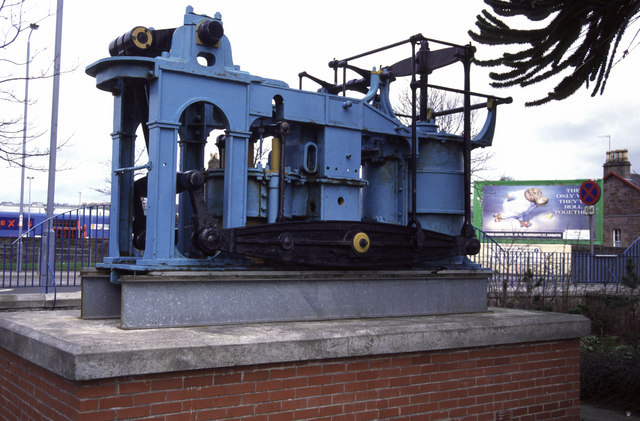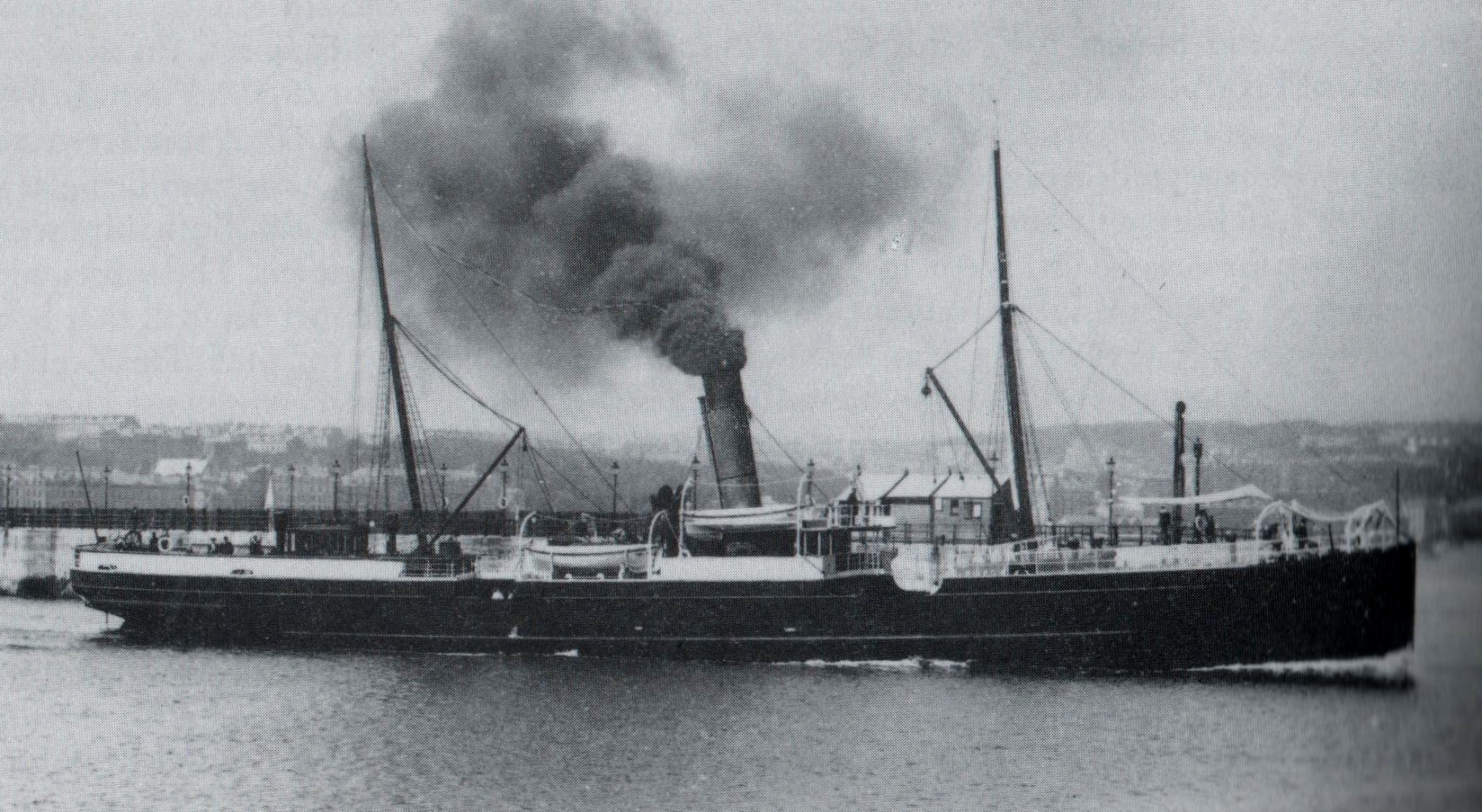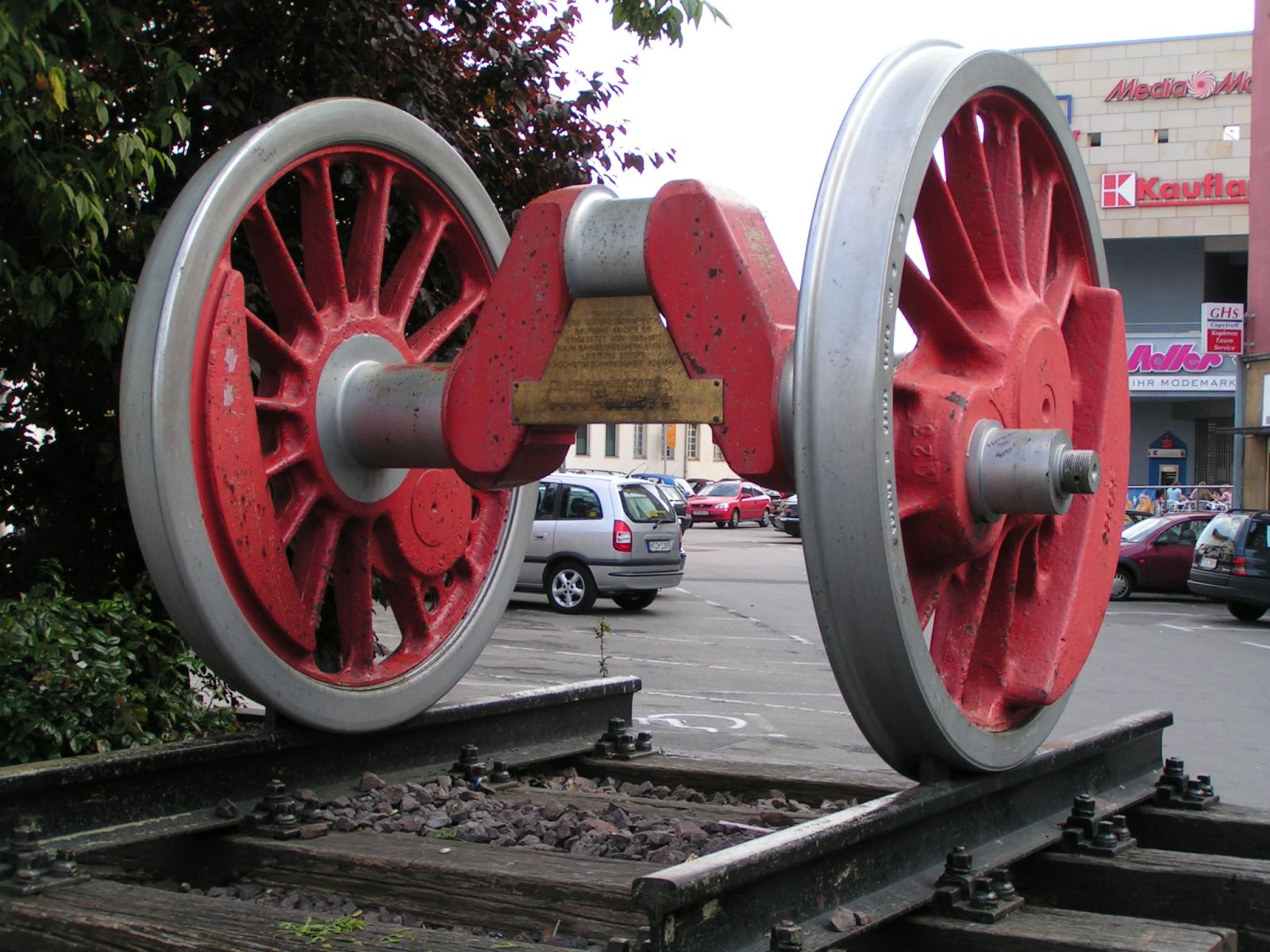|
SS Ellan Vannin (1883)
SS (RMS) (the Manx name for the Isle of Man) was built as an iron paddle steamer in 1860 at Meadowside, Glasgow for the Isle of Man Steam Packet Company. She was originally named ''Mona's Isle'' - the second ship in the company's history to be so named. She served for 23 years under that name before being rebuilt, re-engined and renamed in 1883. As ''Ellan Vannin'' she served for a further 26 years before being lost in a storm on 3 December 1909 in Liverpool Bay. ''Mona's Isle'' ''Mona's Isle'' was built by Tod and McGregor Ltd, Glasgow, at a cost of £10,673. She entered service with the Isle of Man Steam Packet fleet in June 1860. ''Mona's Isle'' is important in the history of the line, as she was the first vessel to be fitted with oscillating engines, which were also manufactured by Tod and McGregor Ltd. Until 1860 the company had always used the side-lever engines favoured by Robert Napier and Sons. The oscillating engine had advantages over the side-lever: it took less s ... [...More Info...] [...Related Items...] OR: [Wikipedia] [Google] [Baidu] |
Isle Of Man
) , anthem = "O Land of Our Birth" , image = Isle of Man by Sentinel-2.jpg , image_map = Europe-Isle_of_Man.svg , mapsize = , map_alt = Location of the Isle of Man in Europe , map_caption = Location of the Isle of Man (green) in Europe (dark grey) , subdivision_type = Sovereign state , subdivision_name = United Kingdom , established_title = Norse control , established_date = 9th century , established_title2 = Scottish control , established_date2 = 2 July 1266 , established_title3 = English control , established_date3 = 1399 , established_title4 = Revested into British Crown , established_date4 = 10 May 1765 , official_languages = , capital = Douglas , coordinates = , demonym = Manx; Manxman (plural, Manxmen); Manxwoman (plural, Manxwomen) , ethnic_groups = , ethnic_groups_year = 2021 , ethnic_groups_ref = Official census statistics provided by Statistics Isle of Man, Isle of Man Government: * * , religion = , religion_year = 2021 , relig ... [...More Info...] [...Related Items...] OR: [Wikipedia] [Google] [Baidu] |
Robert Napier And Sons
Messrs Robert Napier and Sons was a famous firm of River Clyde, Clyde shipbuilders and marine engineers at Govan, City of Glasgow, Glasgow founded by Robert Napier (engineer), Robert Napier in 1826. It was moved to Govan for more space in 1841. His sons James and John were taken into partnership in 1853. The whole Clyde, every engineer and shipbuilder in it, was considered to have benefitted from the firm's achievements and celebrity. By the 1840s it was universally recognised as the finest in Britain. Many firms were founded by former employees.ed. W H Fraser and I Maver. ''Glasgow: 1830 to 1912'' Manchester University Press 1996 After Robert Napier's death in 1876 the plant and goodwill were sold by auction in March 1877 and purchased by a group of engineers led by the previous manager, A C Kirk. It continued to build ships and engines until 1900 when it was incorporated in William Beardmore and Company. Beginnings In 1800 Glasgow had no shipbuilding firms. Aged 23, Robert Nap ... [...More Info...] [...Related Items...] OR: [Wikipedia] [Google] [Baidu] |
SS Fenella (1881)
SS (RMS) ''Fenella'' (I), No.76303, was an Iron twin-screw steamer operated by the Isle of Man Steam Packet Company, and was the first ship in the company's history to bear the name. Construction and dimensions ''Fenella'' was built by the Barrow Shipbuilding Company of Barrow-in-Furness and was launched at Barrow by Miss Barnett on Thursday 9 June 1881.The Isle of Man Weekly Advertising Circular. Tuesday 14 June 1881. Tonnage ; length 200 ft; beam 26 ft; depth 13 ft. The vessel cost £18,750 and was certificated for a crew of 28 and 504 passengers. She had an indicated horsepower of 1,200 and a speed of 14 knots, with a boiler pressure of 85 psi. She was driven by two sets of vertical compound engines, each with cylinder bores of 23 and 42 inches, with a stroke of 24 inches. There was a slight delay in the construction of ''Fenella'', due to a misunderstanding about the construction of her sleeping accommodation. The Isle of Man Weekly Advertising C ... [...More Info...] [...Related Items...] OR: [Wikipedia] [Google] [Baidu] |
Barrow-in-Furness
Barrow-in-Furness is a port town in Cumbria, England. Historically in Lancashire, it was incorporated as a municipal borough in 1867 and merged with Dalton-in-Furness Urban District in 1974 to form the Borough of Barrow-in-Furness. In 2023 the borough will merge with Eden and South Lakeland districts to form a new unitary authority; Westmorland and Furness. At the tip of the Furness peninsula, close to the Lake District, it is bordered by Morecambe Bay, the Duddon Estuary and the Irish Sea. In 2011, Barrow's population was 56,745, making it the second largest urban area in Cumbria after Carlisle. Natives of Barrow, as well as the local dialect, are known as Barrovian. In the Middle Ages, Barrow was a small hamlet within the parish of Dalton-in-Furness with Furness Abbey, now on the outskirts of the town, controlling the local economy before its dissolution in 1537. The iron prospector Henry Schneider arrived in Furness in 1839 and, with other investors, opened the Furness Railwa ... [...More Info...] [...Related Items...] OR: [Wikipedia] [Google] [Baidu] |
New Brighton, Merseyside
New Brighton is a seaside resort in Wallasey, Merseyside, England, at the northeastern tip of the Wirral peninsula. It has sandy beaches which line the Irish Sea and mouth of the Mersey, and the UK's longest promenade. At the United Kingdom Census 2011, 2011 Census, the population was 14,859. History Up to the nineteenth century, the area had a reputation for smuggling and wrecking (shipwreck), wrecking, and secret underground cellars and tunnels are still rumoured to exist. It also had a strategic position at the entrance to the River Mersey, Mersey Estuary. The Fort Perch Rock, Perch Rock battery was completed in 1829. It mounted 18 guns, mostly 32-pounders, with 3 6-inch guns installed in 1899. Originally cut off at high tide, coastal reclamation has since made it fully accessible. In 1830, a Liverpool merchant, James Atherton, purchased of land at Rock Point, which enjoyed views out to sea and across the Mersey and had a good beach. His aim was to develop it as a desirab ... [...More Info...] [...Related Items...] OR: [Wikipedia] [Google] [Baidu] |
Liverpool
Liverpool is a city and metropolitan borough in Merseyside, England. With a population of in 2019, it is the 10th largest English district by population and its metropolitan area is the fifth largest in the United Kingdom, with a population of 2.24 million. On the eastern side of the Mersey Estuary, Liverpool historically lay within the ancient hundred of West Derby in the county of Lancashire. It became a borough in 1207, a city in 1880, and a county borough independent of the newly-created Lancashire County Council in 1889. Its growth as a major port was paralleled by the expansion of the city throughout the Industrial Revolution. Along with general cargo, freight, and raw materials such as coal and cotton, merchants were involved in the slave trade. In the 19th century, Liverpool was a major port of departure for English and Irish emigrants to North America. It was also home to both the Cunard and White Star Lines, and was the port of registry of the ocean li ... [...More Info...] [...Related Items...] OR: [Wikipedia] [Google] [Baidu] |
Renfrewshire
Renfrewshire () ( sco, Renfrewshire; gd, Siorrachd Rinn Friù) is one of the 32 council areas of Scotland. Located in the west central Lowlands, it is one of three council areas contained within the boundaries of the historic county of Renfrewshire, the others being East Renfrewshire to the east and Inverclyde to the west. It also shares borders with Glasgow, North Ayrshire and West Dunbartonshire, and lies on the southern bank of the River Clyde. The term Renfrewshire may also be used to refer to the historic county, also known as the County of Renfrew or Greater Renfrewshire, with origins in the 16th century. The larger Renfrewshire, containing Renfrewshire, Inverclyde and East Renfrewshire, remains in use as a registration county and lieutenancy area as well as a joint valuation board area for electoral registration and local tax valuation purposes. The town of Paisley is the area's main settlement and centre of local government and contains the historic county town, ... [...More Info...] [...Related Items...] OR: [Wikipedia] [Google] [Baidu] |
Ashton, Inverclyde
Gourock ( ; gd, Guireag ) is a town in the Inverclyde council area and formerly a burgh of the County of Renfrew in the west of Scotland. It was a seaside resort on the East shore of the upper Firth of Clyde. Its main function today is as a residential area, extending contiguously from Greenock, with a railway terminus and ferry services across the Clyde. History The name Gourock comes from a Gaelic word for "pimple", in reference to the hill above the town. As far back as 1494 it is recorded that James IV sailed from the shore at Gourock to quell the rebellious Highland clans. Two hundred years later William and Mary granted a Charter in favour of Stewart of Castlemilk which raised Gourock to a Burgh of Barony. In 1784 the lands of Gourock were purchased by Duncan Darroch, a former merchant in Jamaica. He built Gourock House near the site of the castle in what the family eventually gifted to the town as Darroch Park, later renamed by the council as Gourock Park. From a sma ... [...More Info...] [...Related Items...] OR: [Wikipedia] [Google] [Baidu] |
Crankshaft
A crankshaft is a mechanical component used in a piston engine to convert the reciprocating motion into rotational motion. The crankshaft is a rotating shaft containing one or more crankpins, that are driven by the pistons via the connecting rods. The crankpins are also called ''rod bearing journals'', and they rotate within the "big end" of the connecting rods. Most modern crankshafts are located in the engine block. They are made from steel or cast iron, using either a forging, casting or machining process. Design The crankshaft located within the engine block, held in place via main bearings which allow the crankshaft to rotate within the block. The up-down motion of each piston is transferred to the crankshaft via connecting rods. A flywheel is often attached to one end of the crankshaft, in order to smoothen the power delivery and reduce vibration. A crankshaft is subjected to enormous stresses, in some cases more than per cylinder. Crankshafts for single-cylin ... [...More Info...] [...Related Items...] OR: [Wikipedia] [Google] [Baidu] |
Cylinder (engine)
In a reciprocating engine, the cylinder is the space in which a piston travels. The inner surface of the cylinder is formed from either a thin metallic liner (also called "sleeve") or a surface coating applied to the engine block. A piston is seated inside each cylinder by several metal piston rings, which also provide seals for compression and the lubricating oil. The piston rings do not actually touch the cylinder walls, instead they ride on a thin layer of lubricating oil. Steam engines The cylinder in a steam engine is made pressure-tight with end covers and a piston; a valve distributes the steam to the ends of the cylinder. Cylinders were cast in cast iron and later in steel. The cylinder casting can include other features such as valve ports and mounting feet. Internal combustion engines The cylinder is the space through which the piston travels, propelled to the energy generated from the combustion of the air/fuel mixture in the combustion chamber. In an ... [...More Info...] [...Related Items...] OR: [Wikipedia] [Google] [Baidu] |
Crankpin
A crankpin or crank pin, also known as a rod bearing journal, is a mechanical device in an engine which connects the crankshaft to the connecting rod for each cylinder. It has a cylindrical surface, to allow the crankpin to rotate relative to the "big end" of the connecting rod. The most common configuration is for a crankpin to serve one cylinder. However, many V engines have each crankpin shared by each pair of cylinders. Design The crankpin connects to the larger end of the connecting rod for each cylinder. This end of the connecting rod is called the "big end", as opposed to the "small end" or "little end" (which connects to the wrist/gudgeon pin in the piston). The bearing which allows the crankpin to rotate around its shaft is called the "rod bearing". In automotive engines, the most common type of rod bearing is the plain bearing, however Bushing (bearing), bushings or roller bearings are also used in some engines. Configurations In a single-cylinder engine, strai ... [...More Info...] [...Related Items...] OR: [Wikipedia] [Google] [Baidu] |







.png)
